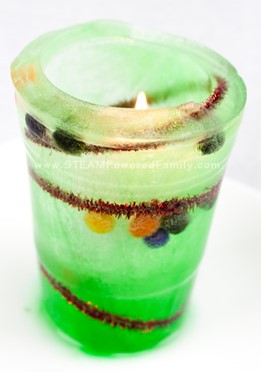
Supplies
- Large plastic cup (like a Solo cup)
- Small plastic cup
- Decorative pieces (pompoms, beads, pipe cleaners, tinsel, pine needle, pine cones, dried berries, etc.)
- Food coloring
- Tape
- Water
- A freezer or it needs to be below zero outside
- Battery operated candle (or tea light)
Directions
The first step is to decide on your decorations. This is the engineering challenge! We found it was best to take pipe cleaners and twist them so they spiraled up on the inside of the large cup. These acted as your garland and as a place to put all your other baubles so they stayed in place.
Now carefully place pompoms and beads so they balance on the garland. This can be challenging and they will move once you add water, so don’t stress too much.
Pro Tip! If you wish to be more environmentally conscious, natural materials like pine needles, small pine cones, dried berries and even small rocks or crystals all worked beautifully as well. The key is that they need to be small.
Once you are happy with your decorations slide the small cup inside the large cup. Tape it into place so the top of the cups are flush with each other.
Add a few drops of food coloring to the water.
Carefully start to add water between the two cups so the water only goes into the larger cup. You will need to add some weight to the smaller cup to keep it in place and stop it popping up. We added a couple of stones to ours to keep it in place.
Fill until the water is only a couple of centimeters from the top. This is important.
Finally, place the lanterns in the freezer (or outdoors) for 5 hours or until completely frozen.
Take A Moment For Science
Once it is frozen take a moment to look at your creation. You should notice that despite the tape and the weights the smaller cup is higher and the ice is to the top of the large cup. This is due to water expanding as it freezes. This is a fantastic opportunity to see this in practice and discuss what happens when water changes states.
Revealing the Lanterns
Now carefully remove the inside plastic cup, then the outer plastic up. You may need to cut the cups to get them off. Just carefully snip the edge with some scissors and you should be able to peel them off.
For safety you can use battery operated candles, plus they won’t melt your lantern like a tea light.
Turn on your candle, set it outside in the wintery cold and enjoy the beauty of your creation!
Tip from STEAMPoweredFamily.com
